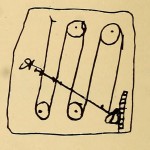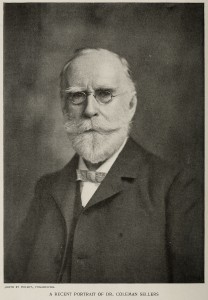Coleman Sellers Biography 1827–1907
A BIOGRAPHICAL SKETCH
By Dr. Henry Morton. A Posthumous Publication [as published in 1903 in Cassier’s magazine]
On April 9, 1902, Dr. Morton, in a letter to the editor wrote: — “I expect to go into hospital for repairs on the 14th and to be laid up for about four weeks. At present the biographical notice of Coleman Sellers, asked for by you, is so advanced that it will be easy for you to get it into shape with the aid that will be given to you by Dr. Coleman Sellers’ son, Coleman Sellers, Jr., who has, in fact, had my manuscript in his hands for some time, to fill up some gaps in the descriptive matter and to supply drawings, etc. I hope before the 14th to put in your hands most, or all, of the manuscript, and then leave you and Coleman Sellers, Jr., to work up anything which may be required. I write now as I may be hurried at the last.”
To the great sorrow of a wide circle of friends, Dr. Morton did not recover from the effects of the surgical operation to which he submitted himself. Death came within a few weeks after the writing of the above lines, and his biographical sketch of Dr. Sellers thus has an added, pathetic interest as being the last work in a long and exceptionally fruitful career. — The Editor, Cassier’s magazine.
INTRODUCTION AND EARLY YEARS [1827 – 1844]
AMONG the men whose genius has contributed to human progress in art, industry or letters, there are some whose mental power appears to be a sudden creative development, not traceable to any ancestral source, while others seem to come by it through inheritance, their predominant capacities appearing to be the result of a natural evolution through a series of generations.
In those of the first class we frequently see combined with marvelous capacities in some one direction a lack of breadth or reach in others, such men, as a rule, being eminently specialists. Where, on the contrary, the influences of heredity are noticeable, we are more apt to find individuals whose mental power is broadly developed and capable of dealing successfully with problems in a wider range of thought. Though such men, from circumstance or environment, may become specialists, they are not limited to their specialties, but evince an aptitude for knowledge in various directions and accomplish useful work in many fields.
Of this latter class Dr. Coleman Sellers is a notable example, both as regards his antecedents and his mental characteristics. His progenitors, for at least five generations, were men of marked mental activity and mechanical aptitude, and it might almost be said that his career came to him by inheritance. His early education was conducted at private schools in Philadelphia until 1838, when, at the age of eleven, he entered at the Academy of Anthony Bolmar at West Chester, Pa. There his interest in natural philosophy was first stimulated by the simple experiments illustrating the lectures delivered to the students, and the trend of his mind at this time is indicated by the entries in a diary, from which the following passages are extracted as examples: —
NOV. 3RD, THURSDAY, 1842.
 Began to make a hygrometer; it is made of cat-gut on which the atmosphere acts, expanding and contracting it, thus moving an index which shows the degrees on a plate. I have been thinking of making one of a piece of ash which, by expanding and contracting, works compound levers which are joined to the index; thus by a slight difference in the wood a great difference will be perceived in the position of the index; it is to be made pretty much on the same principle as those instruments which show the expansive power of metals, only instead of metal a piece of ash is used in the body to be expanded, and instead of being acted upon by the heat it is to be acted upon by the atmosphere.
Began to make a hygrometer; it is made of cat-gut on which the atmosphere acts, expanding and contracting it, thus moving an index which shows the degrees on a plate. I have been thinking of making one of a piece of ash which, by expanding and contracting, works compound levers which are joined to the index; thus by a slight difference in the wood a great difference will be perceived in the position of the index; it is to be made pretty much on the same principle as those instruments which show the expansive power of metals, only instead of metal a piece of ash is used in the body to be expanded, and instead of being acted upon by the heat it is to be acted upon by the atmosphere.
NOV. 4 TH, FRIDAY.
At work at my hygrometer, but could not complete it for want of tools. Made an improvement in the instrument; instead of having a weight fastened to the cat-gut I intend to put a spring in
this manner. A B is the spring fastened to the frame at A and moving with the index at B. The
benefit of this is, that the instrument will work in any position when, if there was a weight fastened
to the string, it could only work when in a perpendicular position.
NOV. 8TH, TUESDAY.
Did my first sums in trigonometry to-day; find it pretty easy. Began to read Waverley by Walter Scott. Began to make a machine to snow that a weight dropped from the mast of a vessel while in motion will take a diagonal direction in its descent and fall at the foot of the mast.
His intense longing at this time for information in natural history, natural philosophy, and chemistry, was not satisfied by the lectures that were delivered to the scholars by a local doctor of medicine. Wanting the assistance of the best text-books, he was compelled to pursue unaided such studies as botany and mineralogy, while to gain all the possible good from the meagre lectures on physics and chemistry, he spent, as the quotations from his diary indicate, much of his spare time in making apparatus to illustrate the facts and theories imperfectly taught in the lecture room.
He completed his course at Bolmar’s Academy in his seventeenth year, and as his mother wished him to become a farmer, he devoted the next two years to practical agriculture; but even on the farm his mechanical bent asserted itself, and, among other devices, he contrived and drew a metal-toothed hay rake, mounted on wheels, which antedated the machine now so generally used, but then unheard of. [continue]

